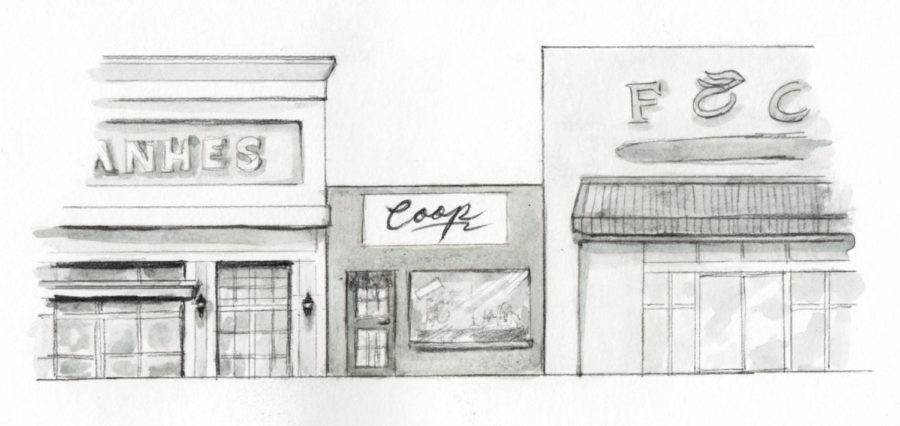Not all ivory towers are made of ivory. Some are ostentatious assemblages of orange bricks and purple windows. Some are Brutalist, but most seem to be Gothic. Some ivory towers will soon overlook trauma centers that were almost never built. But it seems that all of them are found in a particular neighborhood only seven miles south of the Loop.
The University of Chicago and Hyde Park are almost synonymous. The University, including its hospital system, employs over 13,000 people, making it the driving force of Hyde Park’s economy. Thus, it’s safe to say that the University and its students have almost a monopoly over what is built in the neighborhood. Businesses crop up to cater to college students; the University will build or destroy structures supposedly in the name of addressing student needs. But professors and students are not the only residents of this diverse, relatively affluent South Side neighborhood. The University, when trying to accommodate for the wants and needs of its students and faculty, must also address the needs of Hyde Park residents.
Hyde Park has suffered from its fair share of misguided development projects, which continue even to this day. As a former UChicago graduate student detailed in The Atlantic, the opening of both fashion retailer Akira and a Borders bookstore (which closed in 2011) on 53rd Street can be considered unnecessary and completely contrary to the wants in Hyde Park as a whole. In a neighborhood famed for its various independent bookstores—Powell’s, 57th Street Books, and the Seminary Co-Op, to name a few—the opening of a corporate bookstore chain was a waste of space. Akira, meanwhile, “remains conspicuously empty most days.” Additionally, the new dumpling eatery Packed, despite its intentions to put Hyde Park on the map, offers minuscule portions of sustainable ingredients for flagrant prices, out of touch with even student budgets. Pricing is also a concern at the upcoming Hyde Park Taco Station, which peddles tacos with an extravagant $19 price tag. And now, a scant three blocks north of “America’s Most European Supermarket,” a Whole Foods is slated to open later this year, replacing the more affordable Village Foods grocer on Hyde Park’s north side.
From gentrification think pieces to episodes of South Park, Whole Foods groceries are often portrayed as bastions of gentrification. That is not to say that gentrification is necessarily evil or cynical. There are obvious and convenient benefits of revitalization from the University’s point of view; these new businesses would improve admissions perspectives, expand student dining options, and bring more tourism to the future home of the Obama presidential library. But gentrification efforts should instead focus on respectful revitalization, rather than dramatic change and catering to a singular socioeconomic demographic. Chicago is still visibly demarcated by socioeconomic and racial segregation—gentrified displacement of Hyde Park’s African-American residents would only perpetuate the University’s image as an island of privilege on the South Side, where many of the problems discussed in sociology classes are palpable outside. Neighboring Woodlawn has a poverty rate at around 28 percent, and Washington Park—bordering Hyde Park to the west—has a staggering 51 percent poverty rate. Meanwhile, UChicago students enjoy the privilege of openly and safely smoking joints on campus with UCPD assurance—UCPD officers will often stop-and-frisk African-American children from Hyde Park and Woodlawn for no apparent reason. Revitalization in the neighborhood, therefore, must take the University’s privilege into account to establish a sustainable, multicultural community that caters to several income levels.
However, exciting developments in Hyde Park and in neighboring Bronzeville demonstrate the efficacy of revitalization efforts. Bronzeville has often been touted as Chicago’s Harlem; it was renowned as a jazz and R&B mecca as well as a hub for civil rights activism. Today, middle-class African-Americans are moving back into the neighborhood, introducing culture and small business without sacrificing the neighborhood’s integrity and heritage. Likewise, recent projects in and around Hyde Park, such as the Stony Island Arts Bank and the UChicago Local Initiative (which funds and offers support to local South Side businesses) retain the area’s multiethnic cultural DNA while promoting artistic and business development through civic engagement. The University of Chicago was founded on the Gospel of Wealth—the belief that institutions and individuals with economic influence are bound by philanthropic responsibility. It certainly possesses the clout and resources to pursue sustainable development and give back—it’s just a matter of ensuring all Hyde Park residents, students and non-students alike, get what they want and need.
Felipe Bomeny is a first-year in the College.









